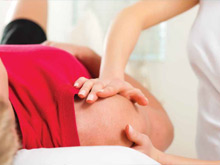Health Topics
-
Healthy Living
-
|
|
April 2012
|
| Physiotherapy Managing Haemophilia |
| Dr Siju K Paul |
| |
 |
Haemophilia is a genetic bleeding disorder characterized by the inability of blood to clot. It is due to the deficiency or absence of one of the clotting proteins called Factor VIII (Haemophilia A) or Factor IX (Haemophilia B) in blood. |
It is in this context that the effort of countless midwives to help with the process of childbirth has to be appreciated, as the International Midwives’ Day falls on May 5th. It was only in the early 1900s with the increasing availability of hospitals that more women began going there for their delivery, as against planning births at home with little medication.
The bleeding tendency in people with Haemophilia may vary according to the severity of gene defects. The bleeding will not be faster but more prolonged than in normal people. In mild and moderate cases of haemophilia, bleeding occurs after trauma or surgical procedures, but in severe form of Haemophilia bleeding happens spontaneously into joints and muscles. The clinical manifestations of internal bleeding include swelling, severe pain, warmth, restricted movements and inability to move the limbs. Whenever such bleeding occurs, haemophilia patients have to be infused with antihaemophilic factor concentrate to control or stop bleeding followed by intense physiotherapy to get back the normal functions of joints and muscles.
In haemophiliacs, the repeated bleeding into the same joints or muscles will result in the evolvement of TARGET joints and muscles. The common target joints for bleeding are knees, elbows, ankles and the target muscles are psoas and calf muscles. The golden rule of physiotherapybased management in haemophilia is DEVELOPING GOOD MUSCLE STRENGTH and JOINT STABILITY. It is required to exercise regularly for a period of minimum three to six months to gain good muscle strength. Activities like cycling and swimming can also help to improve muscle strength
Therapeutic Home Gym Kit: It consists of a pair of squeezable balls, sand bags with a zip, rubber bands having varying tensile strength.
Ball Exercises
For hand and shoulder muscles
- Hold the soft balls.
- t Squeeze by tightening whole upper limb muscles.
It will strengthen entire muscles of the hand, forearm, arm and shoulder girdle
Sand Bag Exercises
Psoas muscle strengthening
- Sit comfortably in a chair with back support.
- Keep the sand bag on your thigh.
- Lift the leg up by bending the hip. It helps to prevent repeated hip muscle bleeding by strengthening the psoas muscles.
Quadriceps muscle strengthening
- Sit comfortably in a chair with back support.
- Keep the sand bag on your ankle.
- Lift the leg by straightening the knees. It helps to improve knee joint stability and mobility by strengthening the quadriceps muscles.
It helps to improve knee joint stability and mobility by strengthening the quadriceps muscles.
Rubber Band Exercises
Triceps strengthening
- Hold the rubber band.
- Stretch out the band by straightening the elbow.
- It helps in preventing/correcting the flexion deformity of elbow by strengthening the triceps muscles
Hamstring muscle strengthening
- Sit comfortably in a chair with back support.
- Put the leg in rubber band loop which is fixed at right angle to a heavy object.
- Stretch the band by bending the knee. It helps to improve knee joint by strengthening the hamstring muscles.
Ankle dorsi flexors strengthening
- Sit on the bed with legs straight.
- Put rubber band loop on the forefoot. Stretch the band by raising the foot up. It helps to improve ankle joint stability and mobility by strengthening the anterior tibial and peroneal muscles.
Ankle plantar flexors strengthening
- Sit on the bed with leg straight.
- Put rubber band loop on the foot.
- Hold the band steady with hand.
- Stretch the band by pushing the foot down.
It helps to prevent calf muscle bleed, and improves ankle joint by strengthening the calf muscles.
|
How To Use The Kit?
- Each exercise has to hold for 10 seconds (a count of 10), followed by 5 seconds
relaxation before repeating. t Each exercise starts with a minimum weight. Gradually progress by increasing the weight and the number of repetitions to achieve a target weight and repetitions and continue the same.
- Exercise regularly with the kit to develop and maintain muscle strength that will avoid / reduce repeated bleeding.
- Apply ice to exercising muscles and joints for 10-15 minutes after completing the exercises to avoid any chance of repeated bleedings.
- Stop the exercise if bleeding occurs in between and consult the physiotherapist before starting again
|
|
| Dr Siju K Paul is Consultant Physiotherapist Haemophilia Society, Bangalore |
|
|